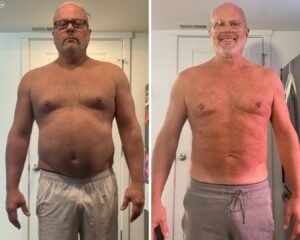A United States survey exploring keto diet success showed that 94% of people who have tried the keto diet have had “positive” or “very positive” changes in their health. These patients have experienced better health and higher energy levels—from weight loss to blood sugar control,
If you’ve considered trying the keto diet, it may be time for you to give it a shot. The ketogenic (keto) diet may help you take control of your health.
To learn about the keto diet and how to start following it, keep reading.
Keto Diet Explained
The ketogenic (keto) diet is a high-protein, high-fat, low-carb option. It’s similar to the Atkins diet and other low-carb diets.
The keto diet is distinguishable by its drastic reduction in carb intake. As you remove carbs from the diet, you replace these carbs with fats. In turn, your body enters a state of ketosis.
Ketosis is a metabolic state that forces the body to burn more fat for energy. At the same time, it turns fat into ketones in the liver. These ketones supply energy for the brain.
Because of these bodily changes, the ketogenic diet can reduce blood sugar while increasing insulin sensitivity.
Is the Keto Diet Healthy?
The keto eating plan leads to multiple health benefits.
Many medically-reviewed research articles show that following a ketogenic diet can help you lose weight while lowering risk factors associated with chronic disease. In fact, the keto diet may be as effective as low-fat diets. However, with the keto diet, you can eat more foods you’re likely to enjoy.
Additionally, this diet can help patients lose weight without calorie counting or food tracking. This is an excellent option for individuals suffering from eating disorders, as counting and tracking can trigger disordered eating.
Ketogenic diets can help you lower blood sugar levels while improving insulin sensitivity. This diet can also help lower diastolic blood pressure and triglyceride levels.
As long as you don’t have an adverse reaction to the change in diet, the ketogenic diet is a healthy choice. If you’re in doubt, you should talk to your physician about what the keto diet can do for you.
What Are the Different Kinds of Keto Diets?
Physicians, nutritionists, and researchers have created multiple kinds of ketogenic diets to care for all sorts of patients. Here are the four main types:
- The Standard Ketogenic Diet (SKD)
- The Cyclical Ketogenic Diet (CKD)
- The Targeted Ketogenic Diet (TKD)
- The High-Protein Ketogenic Diet
The Standard Ketogenic Diet is a low-carb, moderate-protein, high-fat diet. Typically, people starting these diets follow these guidelines: 70% fat, 20% protein, and 10% carbs.
The Cyclical Ketogenic Diet involves cycles of low-carb and high-carb eating. People following this kind of keto diet may follow the Standard Ketogenic Diet for five days and then follow a high-carb diet for two days.
The Targeted Ketogenic Diet allows you to eat carbohydrates around times of intense exercise,
The High-Protein Ketogenic Diet includes more protein than the Standard Ketogenic Diet. Typically, people following this kind of diet follow these guidelines: 60% fat, 35% protein, and 5% carbs.
Most researchers focus on Standard Ketogenic Diets and High-Protein Ketogenic Diets.
The other kinds, the Cyclical and Targeted Ketogenic Diets, are more advanced and should involve getting direction from your physician. Although, these diets are more applicable to athletes.
The Importance of Ketosis
Ketosis is a metabolic state that forces the body to start burning fat for fuel. Your body enters into a state of ketosis when you reduce your consumption of carbohydrates and sugars. Without ketosis, these are the body’s primary sources of energy.
While you can enter ketosis without following a keto diet, a keto diet is the most effective way to do so. The diet limits your carbohydrates to 20 to 50 grams per day. You’re eating various fats such as meats, fish, eggs, and nuts.
While controlling your carbohydrate intake, you should watch your protein intake. The body can convert protein into glucose if you consume too much. If this happens, you may not enter ketosis as quickly as you want.
If you’re looking to enter into ketosis quickly, you may want to try intermittent fasting while following the keto diet. No matter your schedule, there’s an intermittent fasting plan for you. The most common plan limits food intake to 8 hours a day, which requires fasting for the remaining 16 hours of the day.
If you’re unsure whether you’ve entered ketosis, there are blood, urine, and breath tests. These measure the number of ketones that your body produces. If you have an increased amount, your body has entered ketosis.
Additionally, there are many symptoms of ketosis that you can look for: increased thirst, dry mouth, decreased hunger and increased frequency of urination.
Who Should Try the Keto Diet?
The keto diet is medicinal in many ways. Many studies show that the keto diet can reverse the damage done by various chronic conditions. And, it can do so longer than short-term medications and fad diets.
Many medical conditions may become better managed through the keto diet:
- Type 2 diabetes
- Prediabetes
- Metabolic syndrome
- Heart disease
- Cancer
- Alzheimer’s disease
- Epilepsy
- Parkinson’s disease
- Polycystic ovarian syndrome
- Brain injuries
The keto diet originated as a treatment for neurological conditions like Alzheimer’s, epilepsy, Parkinson’s, and brain injuries. Numerous studies have shown that the keto diet may slow the progression and even reverse the damage associated with some of these conditions.
The keto diet has also improved patient outcomes for individuals suffering from these conditions.
For diabetes, prediabetics, and those with metabolic syndrome, the keto diet can increase metabolism, decrease blood sugar levels, and repair insulin function. It can also help you get rid of excess body fat.
Its insulin-repair properties may be what helps the keto diet improve symptoms of polycystic ovarian syndrome (PCOS).
In fact, some of these patients may be able to come off some of their medications while following the keto diet.
As for heart disease and other conditions linked to high cholesterol, the keto diet improves good cholesterol levels, lowers blood pressure, and controls blood sugar.
Who Should Not Do Keto?
Many individuals do not realize that they can’t follow a keto diet until they’ve already tried it. These individuals have adverse effects that are known collectively as the “keto flu.”
If you’re experiencing consistent flu-like symptoms while on the keto diet, you may not be able to follow the diet safely.
While a short flu-like state is normal, it should not extend past a week.
What Foods Do You Eat on a Keto Diet?
The foods you can eat while following the keto diet should comprise most of your meals. Here are some foods you should keep on your diet rotation:
- Meat, including chicken, turkey, ham, sausage, bacon, red meat, and steak
- Fatty fish, including tuna, salmon, trout, and mackerel
- Pastured or omega-3 whole eggs
- Unprocessed cheeses, including cheddar cheese, cream cheese, blue cheese, goat cheese, and mozzarella
- Grass-fed butter and heavy cream
- Low-carb vegetables, including leafy greens, tomatoes, peppers, and onions
- Nuts and seeds, including chia seeds, pumpkin seeds, flaxseeds, almonds, and walnuts
- Healthy oils, including extra virgin olive oil and avocado oil
- Whole avocados or freshly-made guacamole
- Low-carb condiments, including salt, pepper, spices, and herbs
There are plenty of foods that are low in carbohydrates. To make following the diet more manageable, you should consider starting with single-ingredient foods. By sticking to the basics, you’re more likely to follow and adhere to the keto regimen.
What Can You Not Eat on Keto?
The number one rule of the keto diet is to avoid foods high in carbohydrates. Here are some of the most common foods to avoid while following the keto diet:
- Alcohol, including wine, beer, liquor, and mixed drinks
- Unhealthy fats, including processed vegetable oils and mayonnaise
- Grains and starches, including rice, pasta, cereal, and wheat-based products
- All fruit, except for small portions of berries
- Sugary foods, including soda, fruit juice, smoothie, cake, ice cream, and candy
- Beans and legumes, including peas, kidney beans, lentils, and chickpeas
- Unhealthy condiments and sauces, including ketchup, honey mustard, barbecue sauce, and teriyaki sauce
- Low fat or other diet products, such as salad dressing, labeled condiments, and low-fat mayonnaise
This isn’t an extensive list. But, you can identify foods to avoid by considering the number of carbs that each food item has.
How to Follow a Keto Diet Plan for Beginners
Getting started on the keto diet can be challenging, especially if you’re used to eating moderate to high amounts of carbs.
First, you should familiarize yourself with food labels. Using these labels, you can see how many grams of carbs, fats, and fiber there are. You can use these numbers to build your ideal keto diet.
If you want to follow a specific keto diet, you can use the percentages we mentioned earlier as guides.
Planning your meals would also help you follow the plan more closely. You’ll be able to save time and money while ensuring that you’re meeting the correct percentages of fat, carbs, and fiber.
If you’re unsure where to start, you can search for a “free keto diet plan” or “keto diet recipes.” Many resources are available to help you follow the keto diet.
With all of the recipe and meal ideas out there, there are bound to be options that you’ll love. And it’ll reduce your stress while you’re learning more about the keto diet.
You could even opt for a meal-delivery service if you don’t want to have to plan at all. With many meal options, you can choose what you want to eat without doing the prep work yourself.
These meal kits will make it easy to prepare keto-friendly meals for yourself.
There are always frozen keto options if you’re ever short on time and don’t have meal-delivery kits available.
Eating Out on Keto
Consider bringing your own meal or keto-friendly snacks whenever you eat with friends. It may seem weird to eat different foods, but it’s the best way to ensure you follow the diet when you’re following the keto diet for beginners.
Once you’ve followed your keto plan for a while, it’ll be easier to choose the right foods. But, you may need to go with simple choices when starting out.
If you decide to eat out while following keto, do your research ahead of time. Find out where you’re eating and pick your meal beforehand. From your protein source to your side dishes, you should know precisely what you’re ordering and how it fits into your keto diet choices.
We also recommend you have a backup or two just in case the restaurant doesn’t have the food you want to order.
If you’re unsure how to pick keto-friendly options from menu items, you can do a simple Google search. Whether it’s a popular place or not, you can look up the food items and determine whether it fits your keto diet.
When in doubt, the restaurant should have nutritional information about their menu items available.
Keto-Friendly Snacks
If you’re not hungry for a full meal, there are still ways to follow a keto diet while snacking. Here are some of the best keto-friendly snacks to eat:
- Any fatty meat
- Beef jerky
- Any fatty fish
- Keto sushi
- Cheese
- Greek yogurt
- Nut butter
- Olives
- Deviled eggs
- Bell peppers or other veggies
- A small number of berries
- A handful of seeds or nuts
- Keto-friendly snack bars
- 90% or greater dark chocolate
Each one of these snacks makes a great addition to any keto-friendly diet. Just ensure you’re keeping things simple, especially as you’re starting the diet.
Keto Diet Plan for Beginners
Like any diet plan, there are keto diet advantages and disadvantages. Choosing keto-friendly foods can change your life. The keto diet has many benefits, from increased insulin sensitivity to decreased blood pressure.
Although, staying consistent with the diet may take a lot of effort.
To learn more about the keto diet and other ways to improve your health, check out the rest of our blog. We can help you learn more about your body and how to keep it healthy.






0 Comments